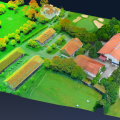
Google Earth is a great program for viewing parts of the world you may never otherwise see, but what about those parts as they existed millions of years ago? A new program developed at Sydney University does just that.
The free, open source program, called GPlates1.0, recreates the continents, oceans, and tectonic plates, as they existed in the far reaches of geological time.
Of course, a direct comparison with Google Earth my not be entirely appropriate, as – despite what the opening line in Star Wars may tell you – there wasn’t anyone around to capture imagery from that time.
Instead, the program’s main focus is to show the spatial locations of the continents, oceans, and tectonic plates, in order to create boundary conditions for computer simulations. Of course, it is also useful for anyone interested in the evolution of the continents over time.
"You ask the software to show you, for example, how the supercontinent Pangaea and the large oceans surrounding it were assembled 200 million years ago. It delivers that by calculating the probable positions, orientations and motions of the tectonic plates through time" said Dietmar Müller, Professor of Geophysics at the University of Sydney's School of Geosciences.
So far, Professor Müller and his collaborators have used GPlates to investigate a number of geophysical mysteries, including how Australia's monsoon evolved through time, how the Rocky Mountains were formed around 70 million years ago, and how New Zealand was torn from the Australian continent around 100 million years ago.
In another promising application, the software may be used to help locate oil, natural gas and mineral deposits far below the Earth's surface. GPlates will enable researchers to uncover associations of specific types of rocks and minerals with plate boundary configurations, mantle hotspots and plate collisions.







